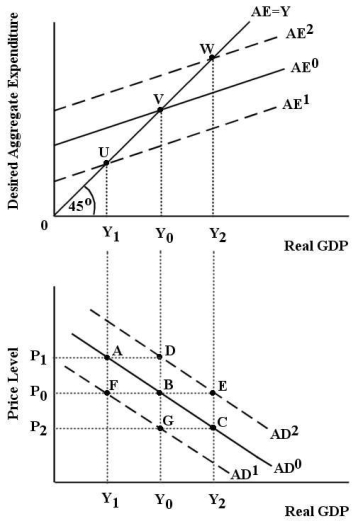 FIGURE 23-1
FIGURE 23-1
-Refer to Figure 23-1.Assume the economy is initially in equilibrium with desired aggregate expenditure equal to real GDP at point V.The price level is  .Now,suppose there is an increase in desired investment and no change in the price level.Which of the following statements describes the likely macroeconomic effects?
.Now,suppose there is an increase in desired investment and no change in the price level.Which of the following statements describes the likely macroeconomic effects?
A) The AE curve shifts up to  ,the AD curve shifts to
,the AD curve shifts to  ,and a new equilibrium is established at point C,with real GDP at
,and a new equilibrium is established at point C,with real GDP at  .
.
B) The AE curve shifts down to  ,the AD curve shifts to
,the AD curve shifts to  ,and a new equilibrium is established at point F,with real GDP at
,and a new equilibrium is established at point F,with real GDP at  .
.
C) The AE curve shifts to  ,the AD curve shifts to
,the AD curve shifts to  ,and a new equilibrium is established at point E,with real GDP at
,and a new equilibrium is established at point E,with real GDP at  .
.
D) The AE curve shifts to  ,the AD curve shifts to
,the AD curve shifts to  ,and a new equilibrium is established at point F,with real GDP at
,and a new equilibrium is established at point F,with real GDP at  .
.
E) The AE curve shifts to  ,the AD curve shifts to
,the AD curve shifts to  ,and a new equilibrium is established at point E,with real GDP at
,and a new equilibrium is established at point E,with real GDP at  .
.
Correct Answer:
Verified
Q1: Consider a simple macro model with a
Q23: In a macro model with a constant
Q29: Q30: Q31: Q33: A leftward shift of the aggregate demand Q36: Consider the relationship between the AE curve Q37: On a graph that shows the derivation Q37: Which of the following would likely cause Q39: Unlock this Answer For Free Now! View this answer and more for free by performing one of the following actions Scan the QR code to install the App and get 2 free unlocks Unlock quizzes for free by uploading documents![]()
![]()
![]()
![]()

